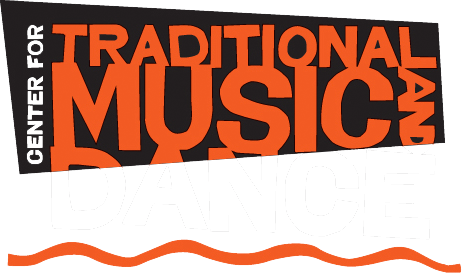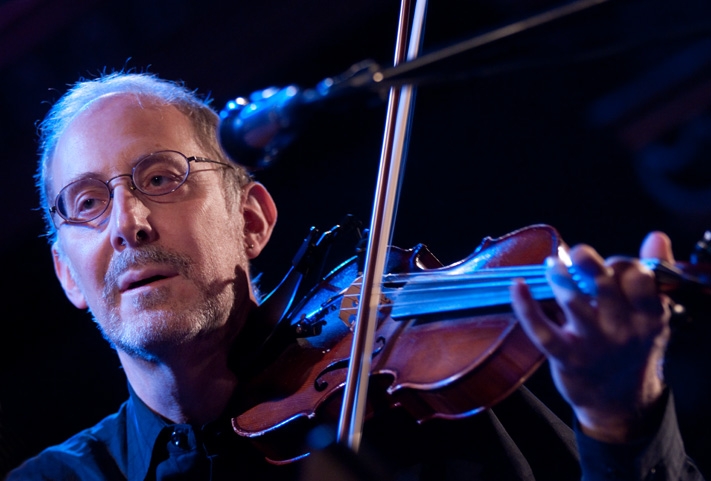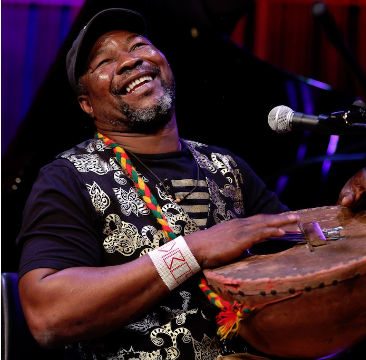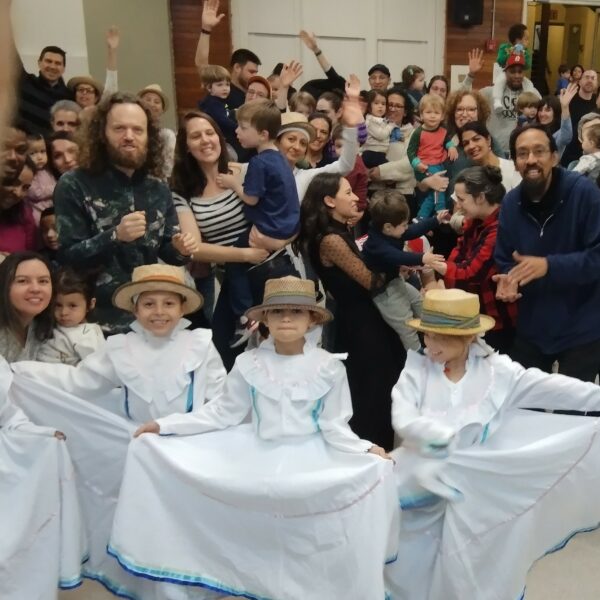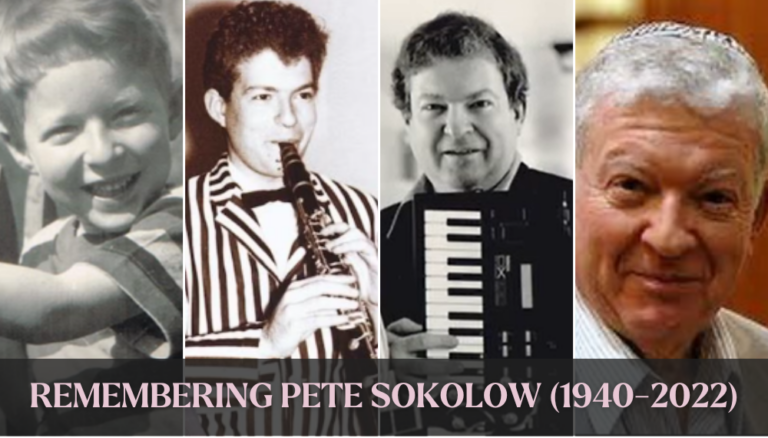Back in 1978 when Zev Feldman helped the Center for Traditional Music and Dance (then known as the Balkan Arts Center) present octogenarian clarinetist Dave Tarras for a landmark series of concerts and a studio recording, he needed to find a way to describe Tarras’s music for a grant application. This was the first project in North America to study and promote interest in Jewish instrumental music, and at the time there was no name for the music in common currency. The musicians themselves were not sure what to call it—often synecdochic terms for particular dance tunes (such as “the bulgars,” or “the freylekhs”) were applied to the entire repertoire.
For lack of a better term, Feldman chose to describe the music Tarras played as “klezmer music.” Up to this point, the term “klezmer” was used by Yiddish speakers as a somewhat derogatory reference to a folk musician, though a few obscure academic articles published in Eastern Europe decades earlier had used it to define the musical genre.
The rest is history. The Tarras project played a large role in spawning a world-wide revitalization, and now “klezmer” is accepted not only as part of English vocabulary, but also many other languages around the world.
Today the dance tradition of Ashkenazic Jewry finds itself in a situation paralleling that of klezmer thirty years ago. Even a name for the form is elusive; “Yiddish dance” seems to have emerged as the term used most amongst aficionados, but one will often find other names employed, including “East European Jewish dance,” “Ashkenazic dance,” “Jewish wedding dance” or even “klezmer dance.”
Worse yet, the practice of Yiddish dance is in dire risk of being lost. While participants at the typical Jewish simkhe (celebrations such as weddings and Bar/Bat Mitzvahs) join hands and move in a circle, they have little or no awareness of the rich choreographies and gestural language that characterized Ashkenazic Jewish dance just one or two generations ago. Israeli dances are practiced, though few participants realize that these are modern choreographies with only a superfluous connection to traditional forms. Though remnants of traditional European Jewish dance are still retained in Hasidic communities, the entire secular dance culture has been forgotten — almost.
“Almost” because of the work of a small number of individuals who have worked to research the dance tradition and teach forms at workshops that would otherwise be forgotten. This month’s Master Artist Profile features two such individuals, who happen to be the co-Directors of CTMD’s Yiddish Dance Project: Michael Alpert and Zev Feldman.
Born in 1954, Michael Alpert grew up in Los Angeles and Boston. His father, Elye-Meir “Alexander” Alperovich was born in Malat (Moletai) in Eastern Lithuania, a small city approximately 70 km north of the Lithuanian capital Vilne (Vilnius). Living near a network of lakes, rivers and forests, Elye-Meir’s family were loggers who would hold contracts with local landowners to cut trees and take them by sled or river to be sold. Alpert’s mother, Frances Clara Greenside, was born in Boston from a family hailing from Chernowitz (Chernovitsi in Ukrainian Bukovina) and Santislav (now Ivano-Franko, in the Western Ukrainian region of Galicia).
Like Feldman, Alpert was a late child for his parents. His aunts and uncles were born in the 1800s, and his zayde (grandfather) was born in 1855. As a result, he experienced the “anachronistic privilege of growing up in an American immigrant Jewish family dating from the late Russian Empire.”
Alpert’s father was trained as an attorney, but worked instead in scrap metal and construction equipment. Though Alpert describes his upbringing as “immigrant working class or lower middle class,” the family had a great thirst for knowledge, and he was always surrounded by books. Much time was spent visiting with his father’s tightly-knit extended family. Though the family had a long association with Lubavitch Hasidism, they practiced a “relaxed version of orthodox Judaism.” This home environment and attendance at a secular Yiddish-shule provided Alpert with early immersion in Yiddish culture.
Alpert remembers being fascinated by the way his father and older relatives would dance at family simkhes—circle dances, freylekhs, kazatskis— the men particularly practiced a style of dance close to that of Hasidim. It was this interest in the dance, music and wider immigrant culture that led him to seek out the “boardwalk scenes” in places like Palisades Park in Santa Monica, Plummer Park in West Hollywood and Revere Park in Boston. As a teenager in Boston, Alpert was exposed to Balkan and international folk dance groups and later made several trips to Yugoslavia and Poland in the early 1970s.
Alpert says these experiences helped him to develop a “systematic approach” to understanding the relationship of music and dance to a culture. As he began to collaborate with other klezmer revival pioneers like Feldman, Andy Statman, Henry Sapoznik, Stuart Brotman and Hankus Netsky, Alpert became particularly concerned with the importance of dance as an essential component of the music’s revitalization.
Moving to New York City in the late 1970s, Alpert was able to carry out research amongst immigrants through a Federal CETA grant in 1979 and 1980 and as Program Director of the Festival of Soviet Jewish Traditions in 1981 and 1982. He would travel with fellow fieldworker Carol Freeman to venues like the Jewish Community House of Bensonhurst and interview immigrants, asking them to recall the songs, instrumental music and dances of their home towns.
Through his fieldwork, Alpert connected with many remarkable individuals, two of whom particularly stand out in relation to Yiddish dance. Alpert describes Bronya Sakina (1910-1988) and Ben Bayzler (1922-1990) as being repositories of an entire cultural world encompassing Yiddish language, music, dance, folktales, and more. Sakina was a wonderful folksinger from Southeastern Ukraine who was able to help Alpert document a number of different dances from this region. Bayzler had been a klezmer drummer and wedding entertainer in pre-WWII Warsaw, and his dance style was representative of a variety of regional influences from Poland and years spent amongst Jewish refugees in Soviet Tashkent.
Alpert’s later career is well-documented in published histories of the klezmer revival (Alpert, by the way prefers “revitalization” to “revival,” noting that the music and dance never really died). He was a founding member of the influential revival band Kapelye, continues to concertize internationally with Brave Old World, serves as the co-Artistic Director of KlezKanada, and was the musical director of the Emmy-award winning documentary “In the Fiddler’s House” that featured violinist Itzhak Perlman, to name just a few highlights of his impressive career. From 1997-2002, Alpert also served as Director of Nashi Traditsii (“Our Traditions”), CTMD’s Community Cultural Initiative in New York’s Soviet Jewish community.
Over the past three decades, Alpert has taught Yiddish dance to tens of thousands of enthusiasts around the world, and has inspired the interest of others who have become active instructors of Yiddish dance, including Steve Weintraub of Chicago, Erik Bendix of Ashville, Helen Winkler of Toronto, Andreas Schmitges of Cologne, Avia Moore of Montreal and Helene Domergue-Zilberberg of Nimes.
Zev Feldman was also inspired by Alpert to turn his formidable research talents to investigating the historical development of Yiddish dance in Europe. Feldman began dancing as a youth at events held by his father’s Bessarabian-Jewish landsmanshaft (a benefit society organized by Jews emigrating from the same town). His father, Meshilim “Max” Feldman was born in 1898 in the Northern Bessarabian city of Yedinits (Yedintsy, now in the Republic of Moldova), into a family of hereditary furriers.
Yedenits is a relatively “new” city, established in the 18th century to encourage settlement of Jewish merchants and artisans who could help raise revenues for the Ottoman Greek “Phanariot” overlords. In 1812, the Russians took control of Bessarabia, creating social upheaval in a region that was home to a multi-ethnic population including ethnic Moldavians, Ukrainians, Ashkenazic and Sephardic Jews, Shwabian Germans, Polish Tartars, Roma (Gypsies), Judaized Geri, Armenians, Turks, Bulgarians and Christian Turkic Gagauz.
Unlike the situation in the Polish Commonwealth, where the klezmorim created exclusively Jewish kapelyes (musical ensembles), the Bessarabian professional ensembles were generally mixed, principally employing Jewish and Rom musicians, but also other nationalities. Yedinits was particularly renowned as a center of klezmer music, and Max Feldman recalled two leaders of the local band, a Jewish violinist and a Rom clarinetist.
Feldman’s mother Rose (Reshe) Gurevitch was from a Jewish family originating in the Mogilev region of Eastern Belarus. Rose was born after the family immigrated to San Therese, Quebec, a small Laurentian town north of Montreal where her father Mikhl, a deeply religious man, worked as a milkman. During the depression, the family moved to the heart of Montreal’s Jewish community, centered on Saint Urbain Street, and later moved to the more suburban Outremont district.
Feldman’s parents met through family contacts and settled on Mosholu Avenue in the Bronx, where Feldman was born in 1949. They later moved to Mount Eden Avenue near the Grand Concourse and Jerome Avenue. There were many Jewish immigrant families in the neighborhood, which teemed with synagogues and Yiddish speakers.
His father loved to dance, and was active in the Yedinits landsmanshaft which frequently held dance parties. Feldman remembers shers (square dance) and bulgars (a circle dance similar in choreography to the Greek hasapiko and Ukrainian arkan) being danced at these events.
The Yedinitser society ceased operations when Feldman was in high school, and he began to seek out comparable dance and music scenes within the Turkish and Greek Sephardic communities of the neighborhood, as well as the Near Eastern nightclubs along Manhattan’s 8th Avenue and the Harut Armenian club in Greenwich Village. Additionally, Feldman would bring home albums from the Albanian-run Balkan Phonograph shop on 8th Avenue and 28th St. and play them to see his father’s reaction, which was often expressed in dance.
At this point, Feldman wasn’t interested in Jewish dance per se, but became more involved in different Near Eastern musics and dance, playing darabuka (drum) with Greek bands and tsimbl (cimbalom/hammered dulcimer), which he was learning from a local Greek player named Paul Lemberis.
After graduating from Music and Art High School, he met a young mandolin virtuoso named Andy Statman who was also exploring oriental musics. With Feldman’s encouragement, Statman sought out Dave Tarras for clarinet lessons.
Under Tarras’s mentorship, Statman and Feldman began playing as a duo on clarinet/mandolin and tsimbl. While Statman was Tarras’s main protégé, Feldman also enjoyed a close musical kinship with Tarras. Though the legendary clarinetist was born in Ukrainian Podolia, he had lived for a time in Yedinits, and frequently played for the Yedinitser landsmanshaft in New York. Additionally, Tarras was a good dancer, and Feldman recalls him demonstrating a number of different dances—honga, hora moldavaneasca, and zhok, as well as improvisations in the Jewish style.
Today Feldman is recognized as one of the world’s leading specialists on klezmer as well as Turkish music. When not in New York (where he lives on the Upper West Side just down the street from Alpert), Feldman is an Associate Professor of Ethnomusicology at Bar Ilan University in Jerusalem, and will be starting a klezmer band this year at the Rubin Academy of Music. His groundbreaking 1978 album with Statman entitled “Jewish Klezmer Music” was followed up with an equally influential album in 2000 by the Khevrisa ensemble, which Feldman formed with violinist Steven Greenman to reconstruct the diverse repertoire of klezmer as it was played in Europe (Khevrisa was later expanded to include Alpert and bassist Stuart Brotman).
Between 2004 and 2007 Feldman was artistic director of the concert series “Music and Dance of Jewish Traditions” at the 92nd Street Y in New York. He is co-editor of the Medimuses Project for Modal Musics of the Mediterranean for the EnChordais School
in Thessaloniki, Greece, sponsored by the European Union. In 2004 he co-directed the successful UNESCO application declaring the Mevlevi Dervishes as a Masterpiece of the Oral and Intangible Heritage of Humanity.
Ultimately, Yiddish Dance can only be preserved in two ways—direct pedagogy from master to student and video. Unfortunately, Labanotation and other descriptive systems are inadequate to describe the nuances of gestures.
Given these challenges, Alpert and Feldman are particularly important to CTMD’ Yiddish Dance Project because their dance repertoires and styles (and family backgrounds) represent very different regional Jewish traditions. Alpert dances with a “Litvish” (Lithuanian) Hasidic-influenced style of dance, while Feldman employs Greco-Turkish-styled hand and arm gestures when he demonstrates the dance style of his father’s Bessarabian Jewish community.
